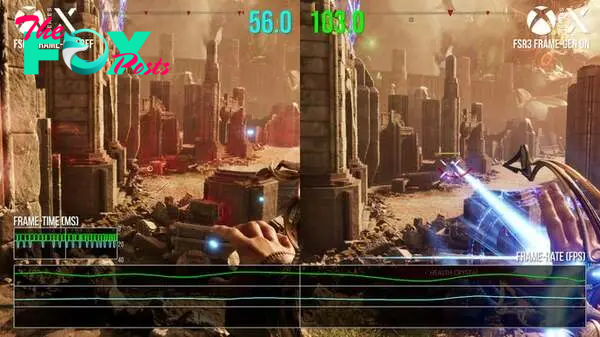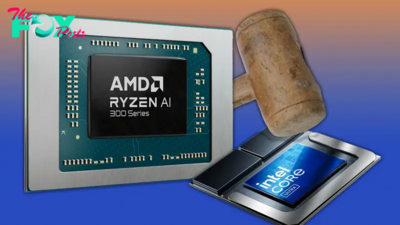Game
DF Weekly: FSR 3 body technology involves consoles – and we have examined it
One other week, one other episode of DF Direct Weekly (therefore the identify) and this episode was truly break up into two recording classes. Regular filming occured on Friday morning, however at round 3pm, Ascendant Studios in affiliation with Enduring Video Games, lastly launched its AMD FSR 3 body Technology improve for Immortals of Aveum. Preliminary testing from myself and John Linneman confirmed that it is in, it is working and it is nicely value speaking about, so I put collectively some knowledge and belongings and we added a second half to the Direct. And right here it’s!
As a proof of idea for console body technology, Immortals of Aveum is compelling, however let’s first take care of the fundamental particulars. Much like Nvidia DLSS 3 frame-gen, AMD’s take works on buffering up an additional body, on high of the one final rendered, then inserts an interpolated body between them. In a finest case state of affairs – principally if you’re CPU-limited with GPU cycles to spare – you may double the frame-rate from the host system, so a 60fps sport turns into a 120fps sport. Nonetheless, if you’re GPU-limited – as is nearly definitely the case with Aveum – positive aspects might be decrease.
The plus factors are apparent although. Within the case of Immortals of Aveum, which tends to run at between 40fps to 60fps, the expertise strikes past the 60fps restrict and into HFR (excessive frame-rate) territory, making the sport extra compelling for these with 120Hz shows. Nonetheless, there are minus factors. Interpolated frames – significantly these sandwiched between two very totally different frames – will lack the constancy of normal frames. Additionally, the method of buffering up an additional body provides latency… and that would be the time taken to generate the additional body together with the time taken to calculate the interpolated body.
- 0:00:00 Introduction
- 0:01:15 Information 01: Immortals of Aveum FSR3 frame-gen examined!
- 0:18:16 Information 02: Hellblade 2 evaluate response
- 0:45:34 Information 03: IGN buys Gamer Community… however what about DF?
- 0:57:44 Information 04: TopSpin 2K25 impressions
- 1:08:14 Information 05: Snapdragon X Elite processors launch
- 1:21:37 Information 06: New Paper Mario: The Thousand 12 months Door particulars
- 1:30:23 Information 07: Ark: Survival Ascended options console menu on consoles
- 1:41:12 Supporter Q1: Ought to ‘inventive’ results all the time be optionally available in video games?
- 1:47:21 Supporter Q2: Ought to a frame-rate cap choice be added to Ghost of Tsushima?
- 1:52:55 Supporter Q3: Future compatibility enhancements are very useful – so ought to they be a typical function in console video games?
- 2:01:32 Supporter This fall: Is VRR changing into a crutch for console video games?
- 2:09:00 Supporter Q5: Are full UE5 titles lastly changing into frequent?
- 2:12:35 Supporter Q6: Which sport ought to get an RTX Remix therapy?
- 2:17:15 Supporter Q7: By 2030, will 8K gaming be ‘a factor’?
So, the large query is easy, then: how does Immortals of Aveum stack up? We’re engaged on a full breakdown protecting all of the current-gen consoles (Collection S has it!) however our first look was at Xbox Collection X, which obtained the patch forward of the PlayStation 5 model. As I anticipated again within the day, Ascendant is not trying to maintain 60fps with frame-gen however moderately to provide a great HFR expertise for HDMI 2.1 shows, particularly with VRR (variable refresh charge).
Nonetheless, there are some fascinating choices. Initially, a brand new toggle has been added that permits customers to allow or disable v-sync. This wasn’t an choice earlier than – it was locked on. There’s additionally the choice to allow or disable AMD FSR 3 body Technology. That is good for customers as a result of whereas we do not like screen-tearing that a lot, tearing at excessive frame-rates in a 120Hz container does remove v-sync judder and may look perceptually smoother. It is also good for Digital Foundry as a result of it means we will check out frame-pacing with our seize playing cards – an space the place FSR 3 body Technology struggled immensely after we first checked out it on PC, however did enhance.
And sure, VRR is natively supported out of the field. On the Collection X, simply allow VRR on the menu, guarantee 120Hz is enabled and also you’re good to go. FSR 3 body technology works nicely in producing interpolated frames and produces a noticeably smoother picture. It is easy to inform the distinction toggling it on and off. It really works. In VRR, the expertise is fluid and that is necessary as a result of frame-rates on Collection X typically sit round 70fps to 90fps. That is nice for VRR, however will current fluidity points with out.
One other factor I discovered fairly intriguing is that even with body technology off however operating at 120Hz, the sport pumps out as many frames as doable, which means that it is doable to run at greater than 60fps. It doesn’thappen so typically with the Collection X model of the sport, nevertheless it does with the Collection S sport, which – bizarrely – outperforms each X and PS5 by fairly a margin, albeit with some outstanding visible downgrades and a really, very low inner decision, pre-FSR upscaling.
I did notice that the Xbox frame-gen implementation is just not excellent. There seem like intermediate freezing points when there is a digital camera lower throughout cinematics, however whereas a bit annoying, it doesn’t intrude on gameplay (a fast have a look at PS5 does not see this situation manifest). That stated, simply typically, Immortals of Aveum has noticeable Unreal Engine traversal stutter. Body-gen can not remedy this and a few would possibly argue that dropping down from an excellent greater frame-rate makes the stutter much more noticeable.
There are HUD points, too. 2D components on the display screen are rendered on the unique frame-rate and are usually not interpolated. This can be a perennial frame-gen situation (DLSS 3 will be affected too) however the situation with Aveum is that these components are semi-transparent, with 3D components seen beneath additionally topic to operating at half-rate.


Nonetheless, the proof of idea is stable. Immortals of Aveum demonstrates that FSR 3 body Technology has worth. In difficult like-for-like content material, I famous that Xbox Collection X frame-rate rose from a 46.68fps common to 80.43fps – a 72.3 % increase. Extra typically, body Technology turns a sport operating inconsistently at between 40fps to 60fps into an HFR expertise, and with VRR lively, it’s compelling. Whereas the interpolated frames are usually not excellent – generally dramatically so – they ‘strobe’ between two normal rendered frames. If the frame-rate’s excessive sufficient, it is exhausting to detect these visible discrepancies.
Now, to reply the obvious query. Will we see 30fps video Games ‘frame-genned’ into 60fps video Games? I do not suppose that is one of the best utility of the know-how, nevertheless it would possibly work on a lot slower-paced titles. Immortals of Aveum represents the way it will work finest – taking a sport already concentrating on 60fps and amplifying the frame-rate into HFR territory. As the sport was a PlayStation Plus month-to-month giveaway and is out now on Recreation Cross, I would advocate giving it a go. I will be again later within the week with an in depth breakdown on all supported techniques, latency evaluation and extra.
Source_link
-

 Game1d ago
Game1d agoWordle at this time: Reply and trace #1245 for November 15
-

 Game1d ago
Game1d agoPhantom of Time free replace provides a brand new class and world, stay at the moment – PlayStation.Weblog
-

 Game1d ago
Game1d agoAvowed Arrives February 18 – Pre-order the Premium Version to Begin Your Journey Early
-

 Game1d ago
Game1d agoFiddly parkour is the key sauce that makes each second of Impasse compelling
-

 Game1d ago
Game1d agoPokémon TCG Pocket to get buying and selling in 2025, new boosters this yr
-

 Game2d ago
Game2d agoWarcraft 3: Reforged 2.0 Patch Notes: Full Record of Modifications Contains Multiplayer Updates, Bug Fixes, and Extra
-

 Game2d ago
Game2d agoExamine Out The Newest Occasions In ‘Marvel Future Combat’ & ‘Marvel Contest of Champions’ – TouchArcade
-

 Game2d ago
Game2d agoSport of Thrones has solely confirmed itself profitable with one spinoff up to now, however now HBO is attempting its hand on the large display screen with a film





















